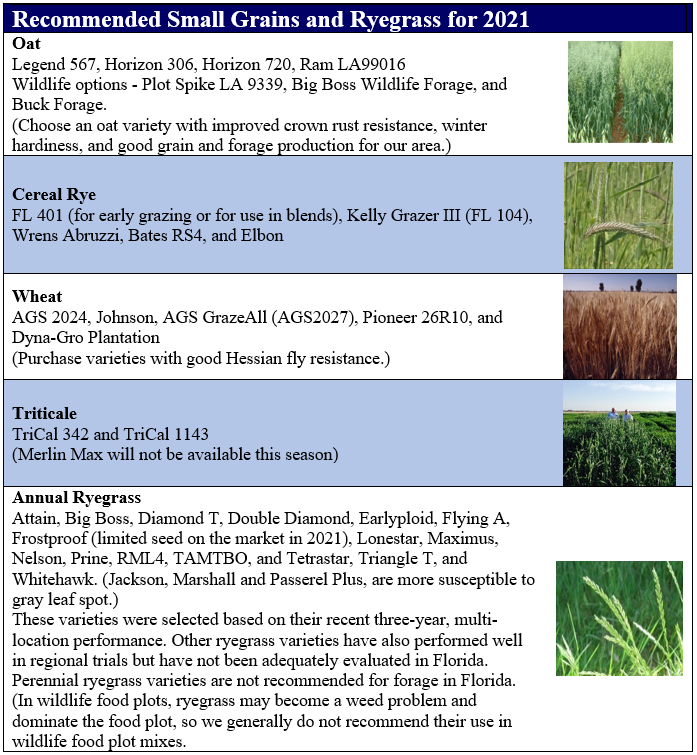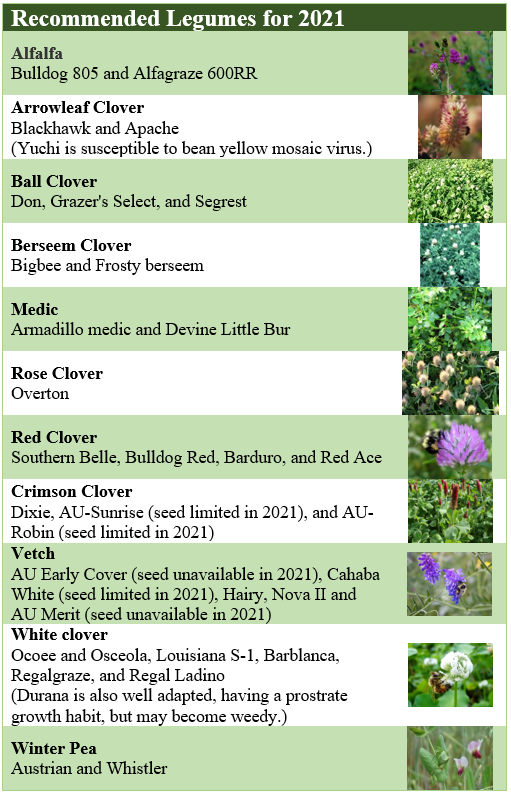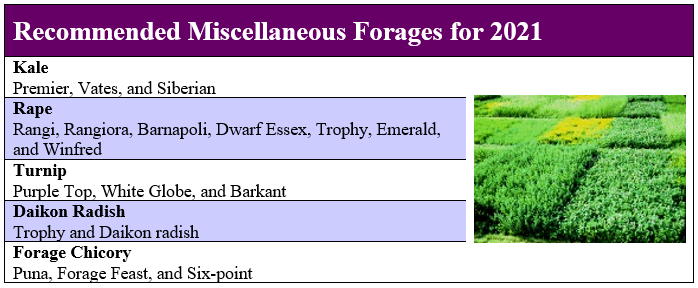Ann Blount, UF/IFAS Forage Breeder, Marcelo Wallau, UF/IFAS Forage Specialist, and Cheryl Mackowiak, UF/IFAS Forage Soil Scientist
The mild weather this week may have you excited and ready to plant some cool-season forages for wildlife or domesticated livestock. That is surely the case for some, as email and phone requests are coming in asking which forage varieties should be included in the 2021 fall forage line-up. Whether you are interested in food plots (as attractants or habitat improvement), or you are providing nutrition for livestock, there are many options available to you that have been thoroughly evaluate by researchers. We also have some well evaluated, multi-species blends that can provide a longer-season forage supply than a single variety.
The 2021 cool-season forage variety recommendations for livestock are available online: 2021 Cool-Season Forage Variety Recommendations for Florida. The Ask IFAS publication for wildlife forage recommendations should be updated shortly with 2021 recommendations, and will be available in the near future using the following link: Cool-Season Forage Recommendations for Wildlife Food Plots in North Florida.
Meanwhile, establishing cool-season forages for wildlife or livestock requires a bit of planning. There is considerably more involved with the preparation than just selecting the variety and top cultivars. Consider the following questions:
- Land preparation: clean-tilled, no-tilled, or over seeded on sod? Generally, planting on a prepared seedbed will improve emergence and production compared to over seeded on sod. Also, both no-till and over seeded will require a drill, while it is possible to broadcast (then cover and roll) the seeds on a prepared seedbed.
– - Soil testing: what is the pH and current soil fertility? Most of our soils in Florida contain limited plant nutrients and are frequently low in pH. The only way to know the soil pH and what nutrients are present is to submit samples for laboratory analysis. The analysis results can then be used to make informed fertility management decisions.
– - Fertilization: pre-plant, post emergence, or no fertilization? On our poor soils, a base fertilization is virtually a requirement to get any plot established, unless it’s an area already being cultivated with legumes and with good soil organic matter. The soil analysis will provide recommendations for fertilization
– - Seed procurement: what, where, how much and when to buy? Many hardware and farm supply stores offer blends of forages for wildlife plantings. Read the label carefully and see what is included in the mix before purchasing, because those blends frequently contain poor-performing cultivars or species that do not grow well in Florida. A better alternative would be to review the suggested variety recommendations in this article, then contact seed companies and see which recommended verities are available in your area. You cany purchase seeds separately and then blend them yourself, perhaps saving you considerable cost.
– - Weed control: chemical, mechanical or neither? When planting a mixture of grass and broadleaf plants (legumes and/or brassicas) herbicide options are virtually nonexistent after the forages emerge. Hence, it is important to control weeds as much as possible before planting (i.e. pre-planting herbicide application, seedbed preparation, etc.) to obtain fast germination and cover (by using good seeds, proven cultivars and adequate fertilization).
–
Key Points to Remember
- Planting cool-season forages on a clean-tilled seedbed results in earlier and greater total forage production, as compared to overseeding grass sod. If overseeding on bahiagrass, the sod should be 30% disturbed with a disc harrow, and using a no-till drill would be preferable to a conventional drill. For overseeding on bermudagrass, a pasture drill or no-till drill can be used alone. Excess warm-season forage should always be removed as hay or from close grazing before planting the cool-season forage.
– - Unless irrigated, the success of winter forage production depends on adequate rainfall. This is especially true when overseeding. Avoid planting into dry fields without adequate soil moisture, and preferably with more rain on the way.
– - Cool-season legumes are more dependable on heavier soils or on sandy soils with an underlying clay layer than they are on deep sands. White clover and ryegrass can also be grown successfully on flatwood soils, where the soil remains moist throughout the growing season.
– - Remember to add the correct inoculant (nitrogen-fixing bacteria) to legume seed before planting. Coated or inoculated seed is available in the commercial market, but seed coatings with bacteria have a limited shelf life, so inoculated seed must be stored and handled properly to maintain the bacteria’s viability. Purchasing raw seed and inoculant separately and mixing just prior to planting is also an option, if a viable inoculant source is available. Be aware of proper storage for pre-inoculated seeds or packaged inoculants, as excessive heat may kill the bacteria. Don’t throw the package on the dash or in the bed of the truck and leave it there for an extended period.
–
Recommended Cool-Season Forages for 2021
–
–
Recommended Cool-season forage blend recipes (per acre rate)
–
Good Grazing/Grass and Legume Mixture for Livestock (with ryegrass)
50 lbs (or 2 Bu) oats
50 lbs (or 1 Bu) triticale or cereal rye
15 lbs ryegrass
6 lbs red clover
15 lbs crimson clover
–
Good Grazing/Grass and Legume Mixture for Wildlife (no ryegrass)
50 lbs (or 2 Bu) oats
50 lbs (or 1 Bu) triticale or cereal rye
6 lbs red clover
15 lbs crimson clover
–
Double Treat Legume Blend (For well-drained sites)
10 lbs red clover
15 lbs crimson clover
—
Triple Treat Legume Blend (For wetter sites)
12 lbs red clover
4 lbs arrowleaf clover
4 lbs white clover
–
Tetra Treat Legume Blend (For medium-drained to well-drained sites)
15 lbs crimson clover
6 lbs red clover
4 lbs arrowleaf clover
2 lbs ball clover
- Cool-Season Forages – A Pasture Perspective for 2022 - September 16, 2022
- Ornamental Rhizoma Perennial Peanut for Groundcover or Alternative Turf - March 18, 2022
- 2021 Cool-Season Forage Recommendations for Livestock and Wildlife - September 24, 2021




